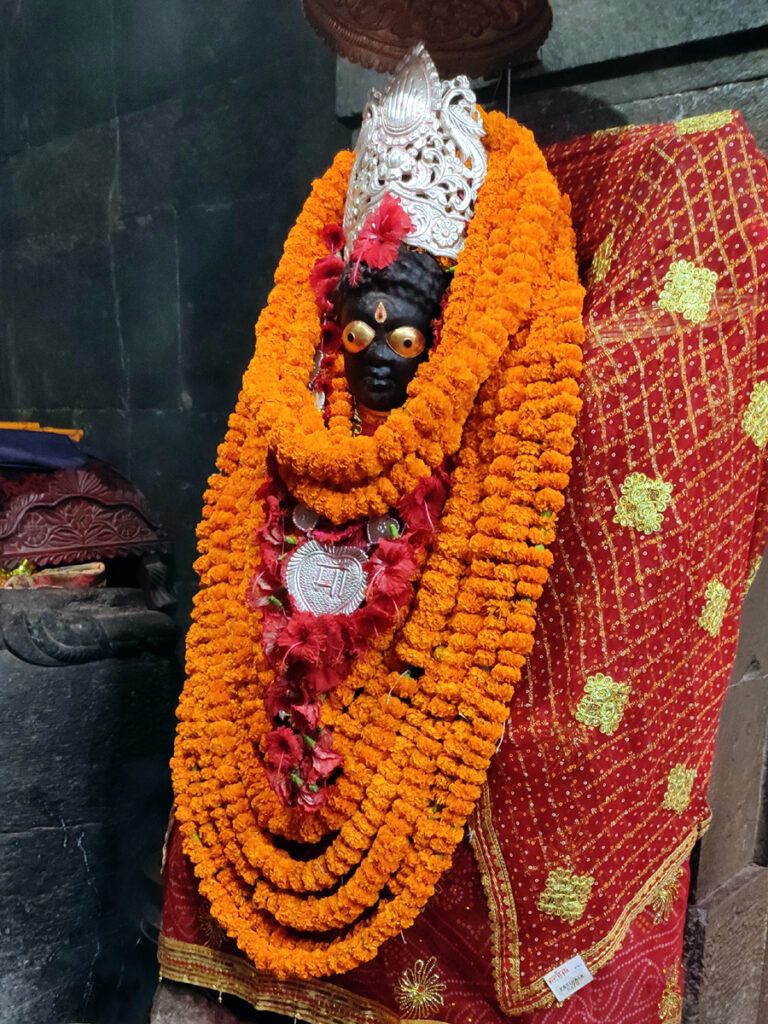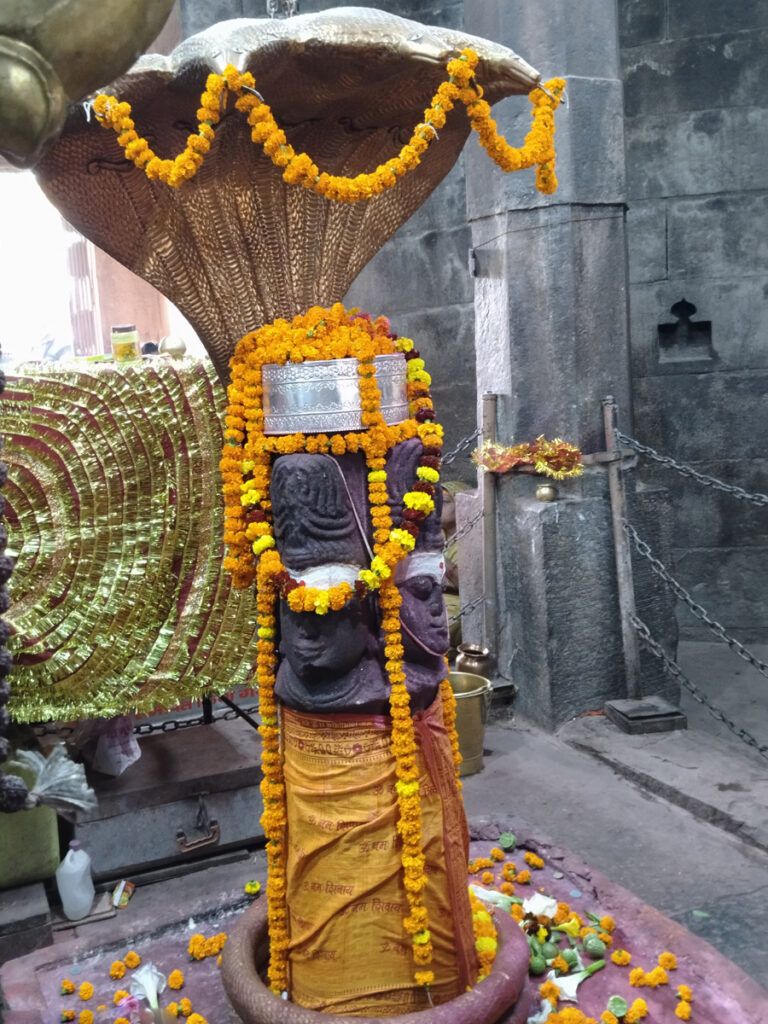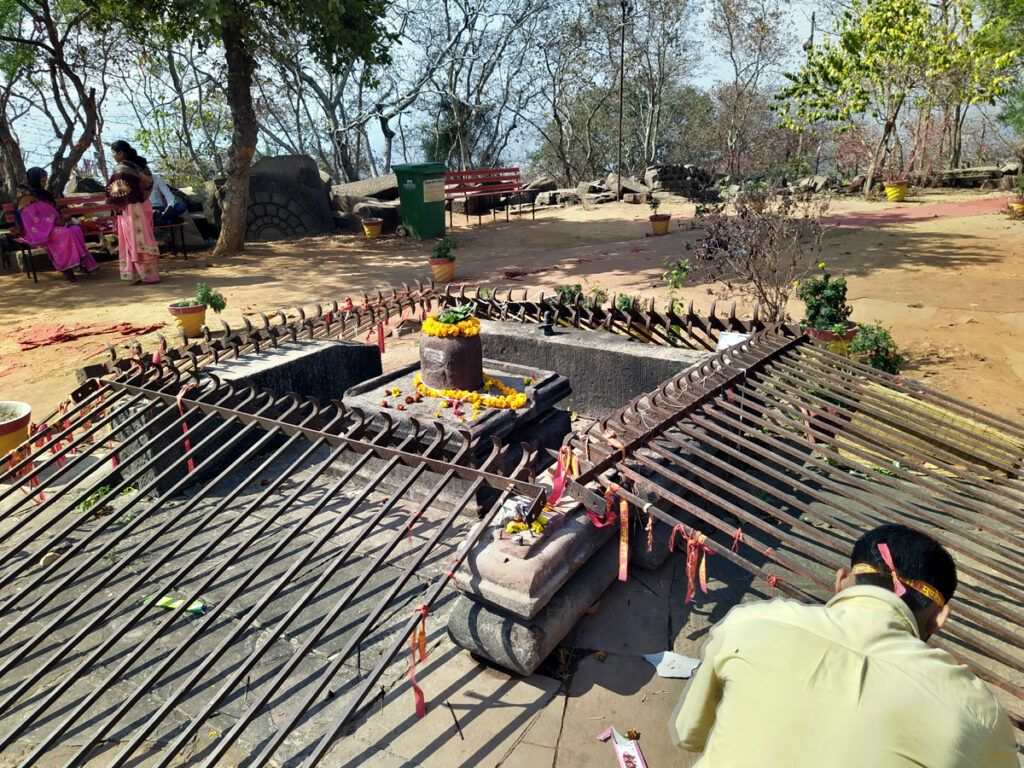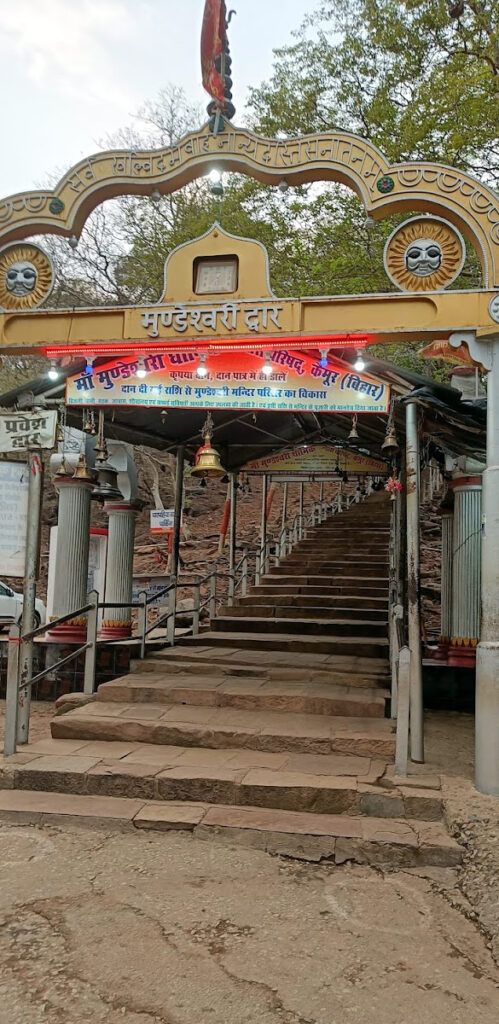Maa Mundeshwari Devi Temple: Unveiling 4th Century Secrets
Maa Mundeshwari Devi Temple is an ancient Hindu temple located at Ramgarh Village, 608 feet (185 m) on the Mundeshwari Hills of Kaimur plateau near Son River, in the Indian state of Bihar. It is an Archaeological Survey of India (ASI) protected monument since 1915.

The temple is considered to be one of the oldest functional Hindu temples in the world, with some sources dating it to as early as the 4th century AD. It is dedicated to the worship of the goddess Durga and god Shiva.
The temple is built in the Nagara style of architecture, which is characterized by its pyramidal shikhara and ornate carvings. The main shrine of the temple houses a murti (idol) of Durga in the form of Vaarahi, a boar-headed goddess. There is also a panchmukhi shivling (five-faced Shiva lingam) in the central part of the temple.
The temple is known for its unique animal sacrifice ritual, in which a goat is brought before the goddess but its life is not taken. The goat is then released unharmed. This ritual is believed to be a symbolic offering to the goddess and a way to seek her blessings.
The Mundeshwari Devi Temple is a popular pilgrimage site for Hindus from all over India. It is especially crowded during the Navratri festival, when devotees come to worship the goddess and seek her blessings.
Contents
- 1 History of Mundeshwari Devi Temple:
- 2 Legend of Mundeshwari Devi Temple:
- 3 Architecture of Mundeshwari Devi Temple:
- 4 Specialty of Maa Mundeshwari Temple:
- 5 Places to visit near Maa Mundeshwari Devi Temple:
- 6 FAQ:
- 6.0.1 What is the Mundeshwari Temple?
- 6.0.2 When was the Mundeshwari Temple built?
- 6.0.3 What is the architecture of the Mundeshwari Temple?
- 6.0.4 What are the main deities worshipped in the Mundeshwari Temple?
- 6.0.5 Is the Mundeshwari Temple a protected monument?
- 6.0.6 When is the best time to visit the Mundeshwari Temple?
- 6.0.7 How to get to Mundeshwari Temple?
- 6.0.8 What are the other attractions near the Mundeshwari Temple?
- 6.0.9 Is there any special puja or ritual that is performed in the Mundeshwari Temple?
- 6.0.10 Is there any special dress code for visiting the Mundeshwari Temple?
- 6.0.11 Is there any photography or videography allowed in the Mundeshwari Temple?
- 7 How to reach Maa Mundeshwari Temple:
- 8 Google Maps:
History of Mundeshwari Devi Temple:
The temple is built in the Nagara style of architecture, which is characteristic of early Hindu temples in North India. The main shrine features a Mukhalingam, which is a phallic symbol of Shiva. The temple also houses images of other Hindu deities, including Ganesha, Surya, and Vishnu.
The Mundeshwari Devi Temple has been continuously worshipped for over 1,700 years. It is a popular pilgrimage site for Hindus from all over India. The temple is also known for its unique architectural features and its rich historical significance.
Here is a brief timeline of the history of the Mundeshwari Devi Temple:
- 6th century CE: The temple is believed to be originally built during the Gupta Empire.
- 10th or 11th century CE: The current structure of the temple is built.
- 12th century CE: The temple is renovated by the Chero kings.
- 1915: The temple is declared a protected monument by the ASI.
- Present day: The temple is still active and is a popular pilgrimage site for Hindus from all over India.
Read More>> Vijayawada Kanaka Durga Temple: A Beacon of Hope & Strength

Legend of Mundeshwari Devi Temple:
The temple is steeped in mythology and legends. One of the most popular legends is that the temple was built by Lord Rama himself. According to the legend, Rama visited the site during his exile. He had a vision of Devi Mundeshwari, who instructed him to build a temple in her honour at the site. Rama then built the temple from a single rock, using his divine powers.
Another legend suggests that the temple was built to honour the goddess’s victory over a demon named Mund. It is believed that the goddess emerged from the demon’s head after he was slain. The temple was built to honour her.
Yet another legend says that the temple was built by a sage named Mundeshwara. He was a great devotee of the goddess Durga, and he wanted to build a temple in her honour. The goddess was pleased with his devotion, and she appeared before him and gave him instructions on how to build the temple.
Read More>> Swaminarayan Akshardham Temple, Delhi | Complete Guide
Architecture of Mundeshwari Devi Temple:
Architectural Style: The Mundeshwari Temple is an excellent example of Nagara-style architecture, which is a style commonly associated with North India. It is characterized by a tall and curvilinear superstructure, intricate carvings, and a pyramidal or shikhara-like tower.
Structure: The temple is built using a combination of stone and brick, with intricate carvings and sculptures adorning the exterior and interior. The temple’s superstructure, or shikhara, is a prominent feature and rises to a considerable height.
Unique Features: What sets the Mundeshwari Devi Temple apart is its unique design, which incorporates both Buddhist and Hindu architectural elements. The temple has a circular sanctum sanctorum, which is a feature commonly seen in Buddhist stupas. This circular design is quite rare in Hindu temple architecture. It is believed that this blend of architectural styles reflects the cultural and religious interchange between Buddhism and Hinduism in ancient India.
Sculptures and Carvings: The temple is adorned with intricate sculptures and carvings of deities, celestial beings, and various other figures from Hindu mythology. These carvings are a testament to the exquisite craftsmanship of the Gupta period.
Material: The temple’s main construction materials are stone and brick. The exterior of the temple is decorated with terracotta panels, which are intricately crafted with scenes from Hindu mythology and daily life.
Sanctum Sanctorum: The circular sanctum sanctorum of the Mundeshwari Temple houses an ancient Shiva lingam, the symbolic representation of Lord Shiva. Devotees visit the temple to offer their prayers and seek blessings.
Location: The Mundeshwari Devi Temple is situated on the Mundeshwari Hills, and its location offers panoramic views of the surrounding landscape.
Preservation: The temple has undergone several renovations and restorations over the years to preserve its ancient heritage. Efforts have been made to protect and maintain this historically significant temple.
Read More>> Yamunotri Temple – Complete Guide

Specialty of Maa Mundeshwari Temple:
- Age: It is one of the oldest functional Hindu temples in the world, dating back to the 4th century AD.
- Architecture: The temple is built entirely of stone and has an octagonal shape, which is quite unusual for Hindu temples.
- Religious significance: The temple is dedicated to the worship of the goddess Durga and god Shiva. It is also a major pilgrimage site for Hindus from all over India.
- Bloodless animal sacrifice: One of the most remarkable features of the Mundeshwari Temple is that although goats are offered as sacrifices, they are not killed. This is a highly unusual practice, as animal sacrifices in other religious traditions often involve the death of the sacrificed animal.
Read More>> Arupadai veedu | Six Abodes of Lord Murugan
Places to visit near Maa Mundeshwari Devi Temple:
Kaimur Wildlife Sanctuary: The Kaimur Wildlife Sanctuary is not too far from the Mundeshwari Temple. It’s a great place for nature lovers and wildlife enthusiasts. You can go on a safari or a nature walk and spot various species of flora and fauna.
Rohtas Fort: Rohtas Fort is a UNESCO World Heritage Site located in the nearby town of Rohtas. The fort was built by the Afghan king Sher Shah Suri and is an architectural marvel. It’s a historical site worth exploring.
Sasaram: Sasaram is a town near Mundeshwari Temple, and it has historical significance. The tomb of Sher Shah Suri, the founder of the Suri Empire, is located here. The tomb is a beautiful example of Afghan architecture.
Chandauti: This ancient town is near Sasaram and is famous for its historical sites and temples. The Mahadeo Temple in Chandauti is a must-visit for its unique architecture.
Deo Markanday Temple: Located in Deo, this temple is dedicated to Lord Shiva. It’s known for its intricate stone carvings and unique architectural style. It’s a place of religious and historical significance.
Kakolat Waterfall: If you’re looking for a natural retreat, Kakolat Waterfall is not too far from Mundeshwari Temple. It’s a beautiful waterfall surrounded by lush greenery and a great place for a day trip.
Bhabua: Bhabua is a town in Kaimur district, and it’s known for its historical sites, including Bhabua Fort. The fort offers great views of the surrounding area.
Sher Shah Suri Park: This park in Sasaram is dedicated to Sher Shah Suri and is a peaceful place for a leisurely stroll.
Veer Kunwar Singh Park: Located in Bhabua, this park is a tribute to the freedom fighter Veer Kunwar Singh. It’s a great place to learn about the history of the region.
Read More>> Divine Mata Vaishno Devi Temple | Shaktipeeth Complete Guide

FAQ:
What is the Mundeshwari Temple?
The Mundeshwari Temple is a Hindu temple dedicated to the goddess Mundeshwari, a form of the goddess Shakti. It is located in the village of Ramgarh, about 608 feet above sea level on the Mundeshwari Hills of the Kaimur Plateau near the Son River in the Indian state of Bihar.
When was the Mundeshwari Temple built?
The Mundeshwari Temple is believed to be one of the oldest Hindu temples in the world, dating back to the 4th or 5th century BC. However, the earliest inscription found in the temple is dated to 635 CE.
What is the architecture of the Mundeshwari Temple?
The Mundeshwari Temple is built in the Nagara style of architecture, which is a famous type of temple architecture in Bihar. The temple is octagonal in plan and has a number of doors and windows on four sides. The temple tower, or shikhara, has been destroyed and a roof was built during renovation. The interiors of the temple have walls with rich carvings and mouldings.
What are the main deities worshipped in the Mundeshwari Temple?
The main deities worshipped in the Mundeshwari Temple are Lord Shiva and Devi Mundeshwari. The sanctum sanctorum of the temple houses a Shivlinga and a murti of Devi Mundeshwari.
Is the Mundeshwari Temple a protected monument?
Yes, the Mundeshwari Temple is a protected monument by the Archaeological Survey of India (ASI).
When is the best time to visit the Mundeshwari Temple?
The best time to visit the Mundeshwari Temple is during the winter months (October to March), when the weather is pleasant.
How to get to Mundeshwari Temple?
The Mundeshwari Temple is located about 120 kilometers from the city of Gaya. The nearest railway station is at Ramgarh, which is about 5 kilometers from the temple. There are regular buses and taxis available from Gaya and Ramgarh to the temple.
What are the other attractions near the Mundeshwari Temple?
Other attractions near the Mundeshwari Temple include:
- The Kaimur Hills, which offer stunning views of the surrounding countryside.
- The Son River, which is a popular spot for swimming and fishing.
- The Ramgarh Fort, which is a historical fort located nearby.
Is there any special puja or ritual that is performed in the Mundeshwari Temple?
Yes, there is a special puja or ritual that is performed in the Mundeshwari Temple every year on the day of Navratri. The puja is performed to please the goddess Mundeshwari and to seek her blessings.
Is there any special dress code for visiting the Mundeshwari Temple?
Yes, there is a special dress code for visiting the Mundeshwari Temple. Visitors are required to wear modest clothing that covers their shoulders and knees.
Is there any photography or videography allowed in the Mundeshwari Temple?
Yes, photography and videography are allowed in the Mundeshwari Temple, but visitors are advised to be respectful of other worshippers and to avoid using flash photography.

How to reach Maa Mundeshwari Temple:
By Air:
The nearest major airport to Mundeshwari Temple is the Varanasi Airport (Lal Bahadur Shastri International Airport), which is approximately 140 kilometers away. From the airport, you can hire a taxi or use public transportation to reach the temple.
By Train:
The nearest railway station is Bhabua Road Railway Station, which is about 22 kilometers from the temple. You can take a train to Bhabua Road from various cities in India and then proceed to the temple by taxi or bus.
By Road:
The temple is well connected by road. You can reach Mundeshwari Temple by road from major cities like Varanasi, Patna, and other nearby towns. Here are the road directions from Varanasi and Patna:
From Varanasi:
Take the NH19 or Varanasi-Bhabua Road south towards Bhabua.
After reaching Bhabua, follow the signs towards Mundeshwari Temple.
From Patna:
Take NH922 or NH139 towards Buxar.
From Buxar, follow the road to Bhabua.
From Bhabua, follow the signs to Mundeshwari Temple.
Local Transportation:
Once you reach the vicinity of Mundeshwari Temple, you can hire a local taxi, auto-rickshaw, or other local modes of transportation to reach the temple itself.

One Comment